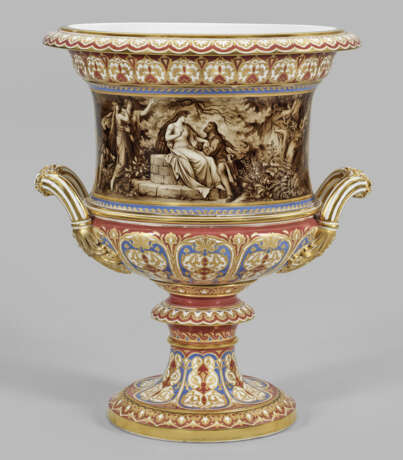ID 801356
Lot 896 | Bedeutende museale Meissen-Kratervase mit Szenen
Estimate value
€ 125 000 – 250 000
aus dem Bilderzyklus "Die schöne Melusine" von Moritz von Schwind
Auf hochgezogenem Rundfuß mit Nodus kelchkraterförmiger, unterhalb gebauchter Korpus, über abgesetztem Profilring in einschwingende Wandung und sich konisch erweiternden Rand mit überfallender Lippe übergehend. Seitlich gebogte, aus tief ansetzenden Akanthusreliefs erwachsende Rundstab-Henkel mit Kannelierung und reliefiertem Palmettendekor. Beidseitig der Wandung von Wellenbandbordüren gerahmte, großflächig angelegte szenische Darstellung aus dem Märchenzyklus "Die schöne Melusine" von Moritz von Schwind, Szenen aus dem Leben der Sagenfigur Melusine thematisierend. Auf der Schauseite, vor imposanter Waldkulisse, an einem Brunnen sitzende Melusine, vor ihr der zur Brautwerbung kniende geliebte Ritter. Links drei stehende, das Geschehen heimlich beobachtende Waldnymphen (Bl. II, betitelt "Am Waldbrunnen"). Auf der Rückseite das thronende Ehepaar mit Kind und Gefolge vor Landschaftshintergrund (Bl. VII, Betitelt "Das Liebesglück"). Monochrome Sepiamalerei in fein nuancierten Brauntönen. Umlaufend, auf frambroisefarbenem Fond, reicher, arabesker Ornamentdekor aus floralen Goldreserven mit Laub- und Bandelwerk zwischen framboisefarbenen, lichtblauen sowie weißen, goldpunktierten Fondflächen. Form-Entw. Ernst August Leuteritz, 1865. Modell-Nr. G 117. Schwertermarke. Meissen. Ende 19. Jh.; H. 55 cm. D. 43.
Die mittelalterliche Sage, die im historischen Kontext auf die französische Familie Lusignan aus dem Poitou zurückgeht, erzählt die Geschichte von Melusine, die einen Ritter nur unter der Bedingung heiratet, dass er sie an einem bestimmten Tag nicht in ihrer wahren Gestalt als Wasserfee sieht, jedoch bricht der Ritter das Tabu. Moritz (Ludwig) Schwind (1804 Wien - 1871 Niederpöcking) ist einer der bedeutendsten Vertreter der Spätromantik und befasste sich in seinem umfangreichen Oeuvre mit zahlreichen Themen aus der Sagen- und Märchenwelt. Die 11 Aquarelle umfassende Bilderfolge "Die schöne Melusine" von 1868/1869 ist Schwinds letzter von drei großen Märchenzyklen und war ursprünglich als Entwurf zu einer Freskendekoration für einen offenen Rundtempel am Ufer des Starnberger Sees geplant. Die 1865 entworfene Leuteritz‘sche Vasenform wurde mit unterschiedlichen Bildfriesen und Bildkompositionen mythologischer und bildkünstlerischer Art ausgeformt, zumeist in Verbindung mit reichem, historisierendem, farbigem und goldenem Ornamentdekor. Die Königlich-Sächsische Porzellanmanufaktur zu Meissen präsentierte diese Vasenform erstmals auf der Pariser Weltausstellung im Jahre 1867 mit der Darstellung des Raubes der Proserpina nach Originalkompositionen von Julius Schnorr von Carolsfeld. Des Weiteren entstand u. a. ein Exemplar mit einem Bacchuszug nach Ernst Julius Hähnel in Platinmalerei auf schildpattartigem Farbgrund.
Vgl. Illustrierter Katalog der Pariser Industrie-Ausstellung von 1867, S. 4; Ausst.-Kat. Meißer Porzellan, 1710 bis zur Gegenwart, Österreichisches Museum für angewandte Kunst, 18982/1983, Nr. 66, Thieme-Becker, Bd. XXX, S. 386ff.; Kat. Königl. Sächs. Porzellan-Manufactur zu Meissen, 1904, Bl. 37, F 191 (In Form und Stil ähnliche Vasen).
A significant museal crater-shaped porcelain vase very finely painted in Sepia with scenes after the eleven-piece picture cycle "Die schöne Melusine" (The beautiful melusine) by the Austrian late Romanticism painter Moritz von Schwind. Modelled by E. A. Leuteritz in 1885. Model no. G 117. Crossed swords mark.
Meissen. Ende 19. Jh.
| Address of auction |
Kunstauktionshaus Schloss Ahlden GmbH Große Str. 1 29691 Ahlden(Aller) Germany | ||||||||||||||
|---|---|---|---|---|---|---|---|---|---|---|---|---|---|---|---|
| Preview |
| ||||||||||||||
| Phone | +49 5164 80100 | ||||||||||||||
| Buyer Premium | 25.0 | ||||||||||||||
| Conditions of purchase | Conditions of purchase | ||||||||||||||
| Business hours | Business hours
|







